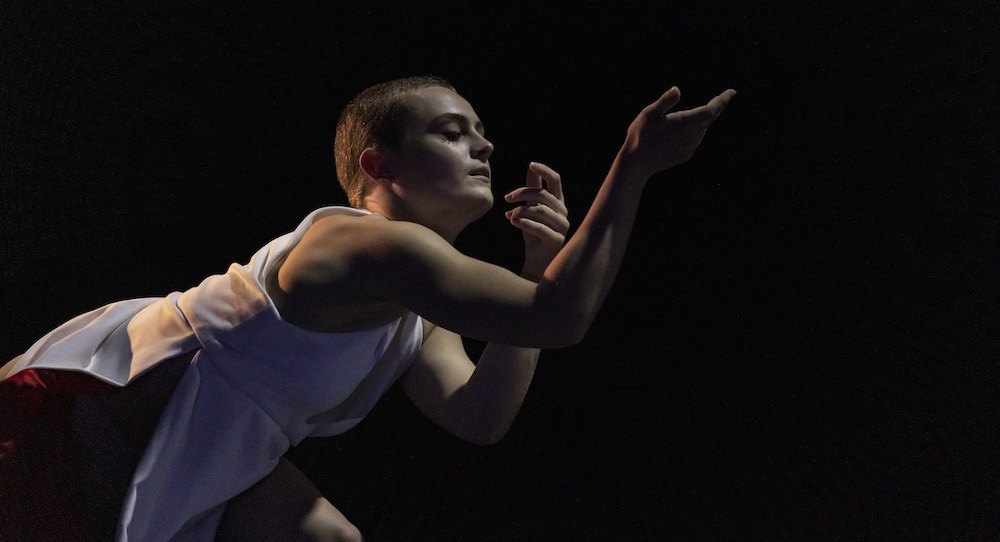Carriageworks, Sydney.
4 December 2021.
This is the eighth year of New Breed, the inspiration of Sydney Dance Company Artistic Director Rafael Bonachela, where four developing choreographers are given the opportunity to create new works on dancers of the company. Costumes, lighting and original scores are all included. This year’s chosen four are Jacopo Grabar, Rhiannon Newton, Jasmin Sheppard and Lilian Steiner.
With the COVID phenomenon, there was a sense of relief and excitement at being able to attend a live performance — all of us audience members having checked in with QR code, flourishing our vaccination certificates, wearing masks and being conscious of social distancing. The dancing was tremendous.
Each of the choreographers introduces their work via video screened at the side of the stage.

The performance of New Breed was off to a powerful, striking start with Given unto Thee by choreographer Jasmin Sheppard. This work deals with colonisation, enforced Indigenous conversion and the takeover of culture and land of Indigenous peoples by the missionaries. Sheppard quotes a compelling fragment from Archbishop Desmond Tutu regarding the missionaries coming to Africa: “They had the Bible and we had the land. They said, ‘Let us pray.’ We closed our eyes. When we opened them, we had the Bible and they had the land.”
Bibles are strewn on the stage. The work opens with wavelike, rolling music and then changes. The dancers wear red and white liturgical outfits, with skin coloured socks, as others represent blood, sacrifice and the land. The dancers at times are writhing, pulsating and form a sculptural mass; there are stretches and twists, at one point Buddha-like poses, at another angular, robotic moves. Sheppard demands a very flexible back, and there is quite a bit of slithery floorwork.

Springtime Again by Lilian Steiner was next, and I am afraid for this reviewer rather disappointing. According to Steiner, it was about being curious and a lava lamp. Performed in total darkness, with UV lighting effects, it wasn’t choreographed as such, every performance being improvised and therefore unique. The dancers in black could not really be seen except for right at the end when the lights were up. Partway through the performance, yet more dancers emerged with what appeared to be wonderfully textured pieces that looked like coral, so visually the work sort of became fish darting around a coral reef.

The third work, exuberant Stereotipo by Jacopo Grabar, was an audience favourite. Meaning “stereotype” in Italian, the work explored the concept of stereotypes by drawing on Grabar’s Italian heritage – including the use of opera, footy moves and a section where stretched extra long spaghetti reunites lovers. Other stereotypes include a ravishing woman and a posing very well gym toned man. With a touch of red, the dancers are in white tops, grey shorts or trousers and grey socks. At times, the use of shadows is important. Grabar’s work demands a beautiful long stretched ‘line’ and there are a couple of intriguing short solos, a combative whirling duet and an intricate trio. Much fun is had regarding a large tomato. Some of the choreography demands a very supple, fluid body. There are some demanding lifts and drags along the floor, and at one point fluttering spiky fingers.

The final work was The Gift of a Warning by Rhiannon Newton. It is concerned with the force of our body’s energy and how we humans transmit and use this and are changing the planet. For some of this piece, the barefoot dancers in their tie-dyed blue jeans are like rocks. For most of the work, there is a very grounded feel, absorbing the Earth’s energy. Yet, at other times, the dancers are like scurrying insects across the floor. There are sudden rolls and an unfolding and closing of the body. Tightly controlled, precise choreography is contrasted with spinning turns, cartwheels and acrobatics and a flurry of windmill-like arms.
A challenging and exciting performance.
By Lynne Lancaster of Dance Informa.

















